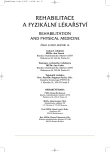ain Syndromes and Neuralgic Amyotrophy of Brachial Plexus – a Contribution to Differential Diagnostics
Authors:
O. Horáček 1; R. Mazanec 2
Authors‘ workplace:
Klinika rehabilitace FN Motol, Praha
přednosta doc. PaedDr. P. Kolář
1; Neurologická klinika dospělých FN Motol, Praha
přednosta doc. MUDr. M. Bojar, CSc.
2
Published in:
Rehabil. fyz. Lék., 14, 2007, No. 2, pp. 39-44.
Category:
Original Papers
Overview
Neuralgic amyotrophy of brachial plexus is a disease beginning with acute pains, which are most often in the region of shoulder, cervical spine or arm and subsequently develop in a motor deficit. The pain is caused by affection of various parts of brachial plexus and peripheral neuropathic pain is therefore present the case. The authors concentrated to five patients examined in the years 2003 – 2006, where this diagnosis was established. In these patients they concentrated to the beginning period of the disease, the various pain syndromes predominated. The following items were examined: 1. interval between the origin of the pain and the evolution of the motor deficit and duration of pain, 2. the first diagnostic conclusion, 3. localization of the pain, 4. character of muscular weakness and electromyographic finding. The pains were in all cases wrongly considered as a symptom of involvement of locomotor apparatus, either affected shoulder joint or a vertebrogenic disorder. It has become obvious that pain is rather specific at the beginning of the disease and it can make differential diagnostics in the beginning period easier.
Key words:
neuralgic amyotrophy of brachial plexus,neuropathic pain, pain syndromes
Sources
1. AMBLER, Z.: Neuropatie a myopatie. Triton, 1999, s. 34-36.
2. SCHADY, W., MEARA, R. J.: Brachial plexus neuropathy. Muscle Nerve, l989, 2, pp. 156-158.
3. PARSONAGE, M. J., TURNER, J. W. A.: Neuralgic amyotrophy: The shoulder-girdle syndrom. Lancet, 1948, 1, pp. 973-978.
4. EHLER, E., AMBLER Z.: Mononeuropatie. Galén, 2002, s. 149-151.
5. VANESTE, J. A., BRONNER, I. M., LAMAN, D. M. et al.: Distal neuralgic amyotrophy. J. Neurol., 246, l999, pp. 399-402.
6. PETRERA, J. E.: Electrophysiological Methods and Clinical Facts in Neuralgic Amyotrophy. Methods in Clinical Neurophysiology, 2, pp 29-59.
7. TSAIRIS, P., DICK, P. J., MULDER, D.W.: Natural history of brachial plexus neuropaty: report on 99 patients. Arch. Neurol., 27, 1972, pp 109-117.
8. OPAVSKÝ, J.: Neuropatické bolesti – patofyziologické mechanismy a principy terapie. Neurologie pro praxi, 7, 2006, 5, s. 270-274.
9. JENSEN, T. S.: Mechanism of neuropathic pain. In: Campbell, J. N. (ed): Pain l996 – An updated review: refresher course syllabus. Seattle, IASP Press, l996, pp. 77-86.
10. MUMENTHALER, M.: Neurology. Georg Thieme Verlag Stuttgart, 1990, p 409.
11. LEWIT, K.: Manipulační léčba. Sdělovací technika, spol. s.r.o., ve spolupráci s ČLK JEP, 2003, s. 295, 296.
Labels
Physiotherapist, university degree Rehabilitation Sports medicineArticle was published in
Rehabilitation & Physical Medicine

2007 Issue 2
Most read in this issue
- ain Syndromes and Neuralgic Amyotrophy of Brachial Plexus – a Contribution to Differential Diagnostics
- Functional Examination of Pelvic Floor
- Determination of the Working Potential of the Individual
- Examination of Working Potential according toe Isernhagen Work Systems FCE (Description According to Available Literature)
